The Kodiak Alaska Department of Fish and Game office door flew open and in tromped two fishermen, one with a loaded shotgun, and both with an attitude. "We need to talk to the biologist" the larger bearded man stepped forward, "the one who closed the shrimppin!" The fishermen told the biologist to

"either open the fishery or there would be trouble," and that's when I got the telephone call.
At the time I worked for the Alaska Department of Fish and Game's Commercial Fisheries Division, at the headquarters' office in Juneau. The Kodiak biologist put me on the telephone with the irate fisherman, the one with the gun. "We are just trying to do our job," I exclaimed, but it was difficult to explain the Department's position to a fisherman who needed to fish, needed to work to pay bills, keep the house, and feed the kids, all the things that are important to any father. Nobody got shot that day, and the Kodiak fishermen were restricted from fishing for shrimp and crab, fisheries that had been worth millions of dollars the year before.
Trophic Regime Shift
Closing the crab and shrimp fisheries in the Gulf of Alaska was the only way the Alaska Department of Fish and Game could protect the breeding stock, but populations continued to decline. That was in the late 1970s, and through the early 1980s. Mid-water trawl surveys done from the 1950s through the 1980s showed the shrimp, crab, and forage fish (small, high-fat, schooling fish such as herring and capelin) populations declined dramatically during the mid-1970s (see Figure 1). Additionally, data showed huge increases in other species, especially larger predatory fish like Pacific cod, walleye pollock, halibut, and arrowtooth flounder. In a few years the Northeast Pacific ecosystem had changed, with a new suite of species dominating the northeast Gulf of Alaska. Scientists refer to this change in species composition as a trophic regime shift. 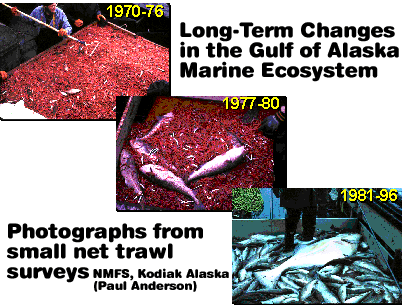
Figure 1 Pictorial evidence of the Northeast Pacific regime shift. The methods and locations for collecting the sample from the mid-water small-mesh trawls were similar from year to year.
At the same time the shellfish population was declining in the Gulf of Alaska, shrimp and crab populations were on the increase in the northwest Atlantic Ocean, off the coast of Newfoundland.
As the Earth warms we can expect the Gulf of Alaska water temperature to increase, but the in the waters off Newfoundland the temperature will probably decrease for a time as cooler water from the melting Arctic Ocean ice cap flushes past. The two oceans appear to be connected, but going in opposite directions.
Regime shifts are a change in the marine ecosystem occurring inter-decadally and globally. They are induced by what is referred to as climate forcing, or increases in global temperatures or global warming. As oceans warm, the habitat used by a suite of small plants and animals (phytoplankton and zooplankton) will change, often promoting an entirely different suite of phytoplankton and zooplankton. Certain phytoplankton and zooplankton will promote a benthic (bottom of the ocean) ecosystem, while others appear to promote a pelagic (free living in the water column) ecosystem. Colder waters in the Gulf of Alaska seem to promote the benthic system, and the same is true for the waters off the coast of Newfoundland. Warm waters in the Gulf of Alaska have been favourable to pollock and flatfish, but also to salmon which have had record survival and returns in Alaska since the 1980s.
Beginning in the late 1970s, Alaska researchers observed numerous changes in the Gulf of Alaska ecosystem. Stellar sea lion and harbour seal populations declined, and commercial fishing was allowed for pollock and other groundfish species. The sea lion population declined to the extent that they were listed as an endangered species. To help protect sea lions some areas were closed to fishing.
Sharks
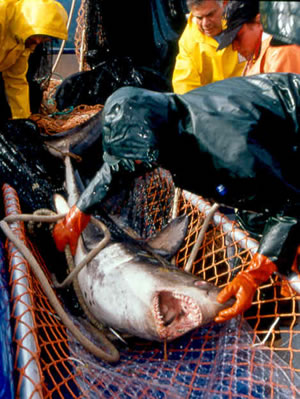 By the 1990s fishermen were starting to report sightings of salmon sharks in the region, and commercial long liners, who fish on the bottom of the ocean for halibut and cod, were catching Pacific sleeper sharks in large numbers. These same fishermen were also losing much of their harvests to feeding sharks that would attack and eat the hooked halibut and cod. A third species of shark, spiny dogfish shark, also became more common. During the 1998 Copper River sockeye salmon fishery, dogfish sharks were so abundant they would often plug up and ruin fishermen's nets.
By the 1990s fishermen were starting to report sightings of salmon sharks in the region, and commercial long liners, who fish on the bottom of the ocean for halibut and cod, were catching Pacific sleeper sharks in large numbers. These same fishermen were also losing much of their harvests to feeding sharks that would attack and eat the hooked halibut and cod. A third species of shark, spiny dogfish shark, also became more common. During the 1998 Copper River sockeye salmon fishery, dogfish sharks were so abundant they would often plug up and ruin fishermen's nets.
By 1996, throughout the region, but especially around Kodiak Island, Lower Cook Inlet and Prince William Sound, large salmon sharks were abundant in bays and passages. Indications were a new top predator had established itself in the Northeast Pacific, possibly influencing the ecosystem as sea lions and seals did before the regime shift.
Alaska Shark Assessment Program
I started the Alaska Shark Assessment Program in 1998 to look at historical data and to begin measuring and tagging sharks. The historical data described shark population increases and fluctuations, raising some theories to explain why the sharks are so abundant. The International Pacific Halibut Commission, and Alaska Department of Fish and Game have data that indicate huge increases in the numbers of sleeper and spiny dogfish sharks in the Northeast Pacific. As a result of investigating the historical data, a pilot field shark research project began in Prince William Sound in 1999. The research team was an informal group coming together to observe and understand this boom in shark numbers. The team had researchers from the Conservation Science Institute, National Marine Fisheries Service, Alaska Department of Fish and Game, and the University of Washington.
Salmon Sharks
Salmon sharks (Lamna ditropis) (above right) are warm blooded, large, and reported to be one of the fastest fish in the ocean. Their outward appearance is similar to that of the great white sharks, which are in the same family. Because they are warm blooded, with a core body temperature of about 80 degrees F, salmon sharks are high energy fish with a high metabolism to match. To stay warm, salmon sharks have an elaborate heat exchange system which keeps their brain, eyes, and muscles warm and functioning at full performance. At more than ten feet in length, and weighing over 700 pounds, but without the fur or blubber that insulates sea otters and seals, salmon sharks need to consume large amounts of prey each day to generate heat. They hunt opportunistically for herring, rockfish, halibut, pollock, spiny dogfish, squid, sablefish (black cod), and of course salmon. They are both active and aggressive predators. I have observed them thrashing the water, sometimes leaving the water completely, as they pursue their prey, often in what appears to be cooperative feeding.
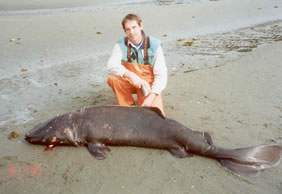 Pacific Sleeper Sharks
Pacific Sleeper Sharks
Pacific sleeper sharks (Somniosus pacificus) (right) are large bottom dwelling predators that can be found at depths of over 2000 feet, and specimens exceeding 20 feet in length have been caught in Alaskan waters. Their list of known prey items includes salmon, pollock, herring, rockfish, halibut, sablefish, shrimp, marine mammals, and even other sharks. We were surprised to find bright pre-spawning salmon in their stomachs, indicating they may in fact be feeding near the surface, probably at night. Over recent years, in some areas, longline fishermen have lost much of their fishing gear and catch to sleeper sharks, forcing them to find other locations to fish.
Spiny Dogfish Sharks
For those of you who have enjoyed fish and chips at your favourite English eatery, you may be surprised to learn you were likely eating spiny dogfish shark (Squalus acanthias). Spiny dogfish get their name from the sharp spines, which are sharp enough to easily pierce my boot and leave a lasting scar, which line their backs, and also from the fact they often travel in packs, like wild dogs might. Dogfish sharks are small, growing to about five feet long, but they make up for this in numbers. Dogfish shark fisheries around the world have targeted this tasty morsel, leading to over-fishing and concern for their populations, although dogfish numbers in Alaska are high in some areas. The dogfish shark appears to locate and utilize patches of prey. This happened during the summer of 1998 when the sharks were feeding on forage fish, eulachon in this case, near the Copper River. The spiny dogfish were so abundant they plugged salmon fishermen's gear, often sinking and destroying nets. Yakutat fishermen sometimes catch so many dogfish sharks they move to other areas or stop fishing. Spiny dogfish also have a varied diet including eulachon, herring, shrimp, crab, rockfish, and pollock.
Shark Behaviour
 All of these sharks are long lived. We know very little about their reproductive behaviour, except that, in common with many long-lived animals, the rate is low. The longest gestation period is probably that of the spiny dogfish shark which lasts 22-24 months, exceeding that of elephants and whales. All three of these shark species can be found in the waters of Alaska year round, but the salmon and dogfish sharks are migratory, possibly leaving the Gulf of Alaska waters and returning during the summer.
All of these sharks are long lived. We know very little about their reproductive behaviour, except that, in common with many long-lived animals, the rate is low. The longest gestation period is probably that of the spiny dogfish shark which lasts 22-24 months, exceeding that of elephants and whales. All three of these shark species can be found in the waters of Alaska year round, but the salmon and dogfish sharks are migratory, possibly leaving the Gulf of Alaska waters and returning during the summer.
The shark research efforts are designed to determine feeding habits, numbers and movements of salmon and sleeper sharks. One of the tagged salmon sharks was recaptured 650 miles to the south only 48 days later. We suspect female salmon sharks, migrate to the coastal waters of California to give birth to pups in the warmer waters, a behaviour that they share with whales which also often move to warmer water to give birth. We also deployed tags that collect depth, temperature and location data, disengage from the shark at a preset time, and relay their data to satellites. This information has been useful in understanding shark behaviours which may help us understand their importance and influences on the marine ecosystem.
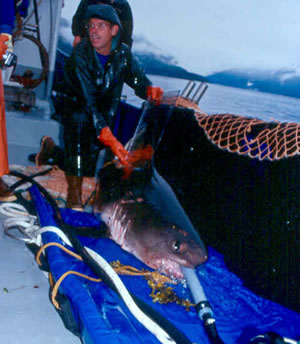 During the field work we were accompanied by National Geographic Society Television, and the British Broadcasting Corporation (BBC) television crews. BBC was filming for their series on the oceans and had especially good shark filming opportunities in Prince William Sound. National Geographic Society deployed their CritterCam which is strapped to a salmon shark's dorsal fin and operates underwater as the shark swims about. At a preset time the camera releases from the shark and floats to the surface where it is collected. Some of this film footage may appear on television.
During the field work we were accompanied by National Geographic Society Television, and the British Broadcasting Corporation (BBC) television crews. BBC was filming for their series on the oceans and had especially good shark filming opportunities in Prince William Sound. National Geographic Society deployed their CritterCam which is strapped to a salmon shark's dorsal fin and operates underwater as the shark swims about. At a preset time the camera releases from the shark and floats to the surface where it is collected. Some of this film footage may appear on television.
The salmon sharks we caught were big, with mouths full of teeth, and weighed upwards of 400 pounds. It was sometimes difficult to control the fish on board while taking measurements and attaching tags and the CritterCam. In order to protect the fish from injuring itself we moved the shark into a crib, covered their eyes with a damp cloth, and placed a hose in their mouth to keep seawater flowing over their gills (right).
Salmon sharks (right and above) are at the top of food web and therefore have few predators, although I noticed scrapes and puncture wounds on many of them which are probably the results of encounters with killer whales (left)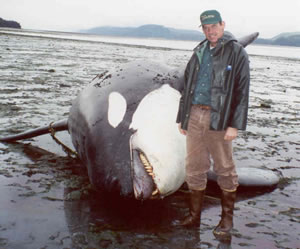 which prey on salmon sharks whenever they can. Indeed, humans also find salmon sharks palatable and salmon shark charters have become popular in Prince William Sound and Lower Cook Inlet. Fishermen are allowed to keep one salmon shark per day and two per year, and their success rate is high. Sharks caught by commercial fishermen are sometimes also killed, but it's not known how many sharks die in this way each year.
which prey on salmon sharks whenever they can. Indeed, humans also find salmon sharks palatable and salmon shark charters have become popular in Prince William Sound and Lower Cook Inlet. Fishermen are allowed to keep one salmon shark per day and two per year, and their success rate is high. Sharks caught by commercial fishermen are sometimes also killed, but it's not known how many sharks die in this way each year.
 The regime shift is but one explanation for the increased shark populations in Alaska. Sharks may be more abundant due to increases in salmon populations (an important food for sharks), decreases in high-seas gillnetting, or merely a shift to warming waters. Some scientists believe the regime shift and dramatic changes to the ecosystem are the result of global warming flexing its muscles. New evidence for global warming and climate change appears in scientific publications every day; the Arctic Ocean ice cap is much thinner than a few decades ago, carbon dioxide (a greenhouse gas) is at the highest levelsin 400,000 years, and continues to increase, and Earth's temperature reached new record highs in the last decade. If global warming continues, you can expect more changes on land and in the ocean, including more regime shifts and changes in the species composition of the Northeast Pacific waters.
The regime shift is but one explanation for the increased shark populations in Alaska. Sharks may be more abundant due to increases in salmon populations (an important food for sharks), decreases in high-seas gillnetting, or merely a shift to warming waters. Some scientists believe the regime shift and dramatic changes to the ecosystem are the result of global warming flexing its muscles. New evidence for global warming and climate change appears in scientific publications every day; the Arctic Ocean ice cap is much thinner than a few decades ago, carbon dioxide (a greenhouse gas) is at the highest levelsin 400,000 years, and continues to increase, and Earth's temperature reached new record highs in the last decade. If global warming continues, you can expect more changes on land and in the ocean, including more regime shifts and changes in the species composition of the Northeast Pacific waters.
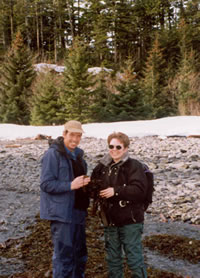 Sharks are at the top of the marine food web, so they exert a top-down control that can impact upon the entire food web. Future work on sharks in the Northeast Pacific will look at shark predation effects on such species as salmon, sea otters, and seals. I hope to learn how sharks fit into the Gulf of Alaska ecosystem, and to determine if the changes in their populations are an indicator of more changes on the horizon.
Sharks are at the top of the marine food web, so they exert a top-down control that can impact upon the entire food web. Future work on sharks in the Northeast Pacific will look at shark predation effects on such species as salmon, sea otters, and seals. I hope to learn how sharks fit into the Gulf of Alaska ecosystem, and to determine if the changes in their populations are an indicator of more changes on the horizon.
References
- Previous The Great White Shark
- Next Big Fish, Little Sea









Comments
Add a comment